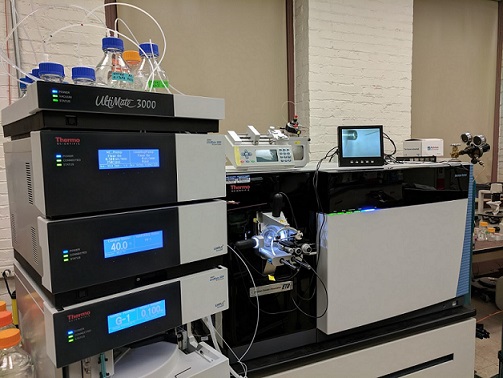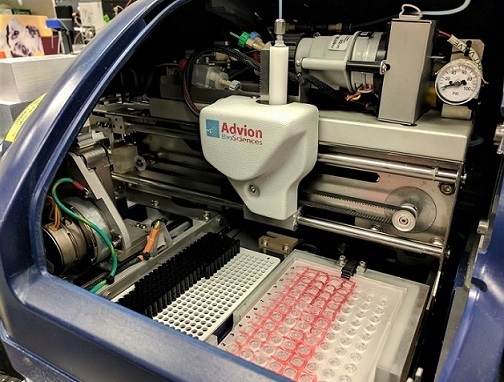MASS SPECTROMETRY
Protein/Peptide Mass Spectrometry Analysis
The Protein Sciences Facility offers mass spectrometry based mass determination and identification of both proteins and peptides. We primarily analyze samples via ESI LC-MS using an Ultimate 3000 nanoflow LC coupled to a Thermo Orbitrap Fusion Tribrid mass spectrometer or to a Thermo Q Exactive HF-X mass spectrometer . We also have an Advion TriVersa NanoMate that can be coupled to the Fusion MS for high-throughput infusion experiments using chip-based static ESI. This is particularly useful for top-down protein characterization and small molecule analysis.


Protein Identification By Proteolysis Followed By Mass Spectrometry And Database Searching
Sample handling:
This procedure is sensitive to protein contamination from extraneous sources such as containers, reagents, and your hands and clothing. To avoid poor results it is important to keep everything that comes in contact with the sample as clean as possible. This requires the use of properly cleaned containers and wearing lab coats and gloves when handling samples. All reagents must be of high quality, as free of contaminants as possible, and freshly prepared. If possible, use low-binding microcentrifuge tubes to limit sample loss due to surface adsorption.
Sample submission:
Samples can be submitted either as gel slices or as liquid samples. For the best protein sequence coverage, samples should be composed of as few proteins as possible, i.e. a single band or spot from a gel, or a single protein in solution. Liquid samples should be as free of salts, detergents, buffers and non-volatile components as possible. See the table below for a list of components to avoid. Samples blotted to PVDF membranes can also be analyzed, but generally the sensitivity will be lower. Samples from Western blots will generally not yield useful results.
Liquid samples: Submit at least 10 picomol in no more than approximately 20 microliters
Gel pieces: Submit at least 50 picomol of protein. It is not necessary to completely destain the gel piece. If something other than a Coomassie dye is used, please make sure the stain is compatible with mass spectrometry analysis. Contact us beforehand if it is not clear whether the stain will be compatible.
Database searching:
Please provide any additional information on the protein sample that is available, such as apparent molecular weight, name of organism, expected post-translational modifications, etc. This will facilitate the database search for protein identification.
Intact Protein Analysis By Mass Spectrometry
Sample handling:
To avoid losses from adsorption to surfaces, use clean polypropylene tubes. Avoid polystyrene, glass, or autoclaved containers.
Use only freshly prepared, high purity reagents and solvents. Mass spectrometers are sensitive to ionic contaminants from any source including buffers, detergents, bacteria, molds, etc.
Wear gloves and lab coats when handling and transferring samples. Proteins from your hands can contaminate your samples.
Sample submission:
Protein samples for intact mass analysis should be dry or in solution and as concentrated as possible. Intact mass analysis cannot be performed on proteins from gels or blots. If possible, submit samples in 200 microliter low-binding microtubes in order to maximize sample recovery.
Protein samples should be as free of salts, detergents, buffers, and non-volatile components as possible. Volatile solvents are generally acceptable.
The sample should NOT contain any
- Azide
- Brij 35 Tris, CHAPS, Triton X - 100
- DMSO Tween, SDA, Glycerol
- DMF,
- Tris, Phosphate and salts > 100mM
The following components are ACCEPTABLE
- Acetic or formic acid
- Acetonitrile, ethanol
- Methanol
- Sodium chloride up to 10 mM
All work performed by the Roy J. Carver Biotechnology Center (CBC) should be acknowledged in scholarly publications, posters, and presentations. Proper recognition allows us to measure the impact of our work and supports our initiatives in obtaining sponsored funding. In addition, any CBC personnel who make a substantial intellectual or experimental contribution are deserving of further recognition as co-author.
